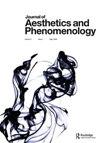Eros and Sensation: Art and Aesthetics in Emmanuel Levinas’s Prison Notebooks
IF 0.2
0 PHILOSOPHY
引用次数: 0
Abstract
ABSTRACT The release of Emmanuel Levinas’s Prison Notebooks (Carnets de captivité) as a part of the first tome of his collected works has further illuminated the extent of the philosopher’s preoccupation with art, especially literature. Levinas’s own literary efforts have been well documented, but less attention has been paid to the relationship between the Prison Notebooks and Levinas’s early philosophy of art. In this article, I suggest that much of what Levinas has to say apropos art in his early philosophy can be traced back to meditations undertaken in captivity. I will unearth the influence of the Prison Notebooks in three articles from the 1940ʹs “L’autre dans Proust,” “La réalité et son ombre,” and “La transcendance des mots.” I argue that in Levinas’s early philosophy of art follows two distinct “paths”: the path of eros and the path of sensation. On one hand, Levinas questions how and if literature can do justice to the question of alterity, whereas on the other he seeks to make sense of the relationship between art and sensibility. I argue that in his notebooks Levinas offers an account of the meaning of sensations that forms the basis of his early aesthetics. Thus, the study of the Prison Notebooks is important as it allows us to see how Levinas’s early philosophy of art, including his seminal “La réalité et son ombre,” functions as a continuation of a philosophical project already begun during his time in captivity.爱欲与感觉:伊曼纽尔·列维纳斯监狱笔记中的艺术与美学
伊曼纽尔·列维纳斯(Emmanuel Levinas)的《监狱笔记》(Carnets de captivit)作为他的第一部作品集的一部分,进一步阐明了这位哲学家对艺术,尤其是文学的关注程度。列维纳斯自己的文学努力已经被很好地记录下来,但很少有人关注监狱笔记和列维纳斯早期艺术哲学之间的关系。在这篇文章中,我认为列维纳斯在他的早期哲学中关于艺术的大部分言论都可以追溯到被囚禁时进行的冥想。我将在20世纪40年代的三篇文章中揭示《监狱笔记》的影响:《普鲁斯特的生活》(L’autre dans Proust)、《我的人生》(La remacalit et son ombre)和《超越一切》(La transcendance des mots)。我认为列维纳斯早期的艺术哲学遵循两条截然不同的“路径”:爱欲之路和感觉之路。一方面,列维纳斯质疑文学如何以及是否能够公正地对待另类的问题,而另一方面,他试图理解艺术与感性之间的关系。我认为列维纳斯在他的笔记中提供了一种对感觉意义的描述,这构成了他早期美学的基础。因此,对《监狱笔记》的研究是很重要的,因为它让我们看到列维纳斯的早期艺术哲学,包括他开创性的“La r alit et son ombre”,是他在囚禁期间已经开始的哲学项目的延续。
本文章由计算机程序翻译,如有差异,请以英文原文为准。
求助全文
约1分钟内获得全文
求助全文

 求助内容:
求助内容: 应助结果提醒方式:
应助结果提醒方式:


